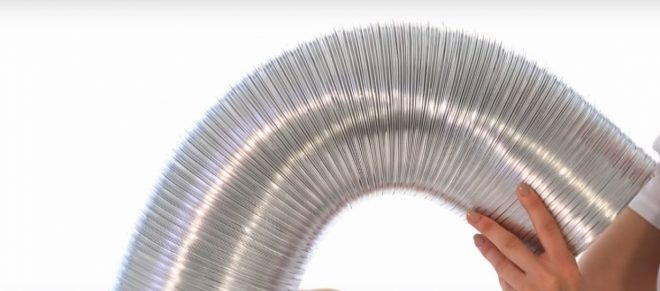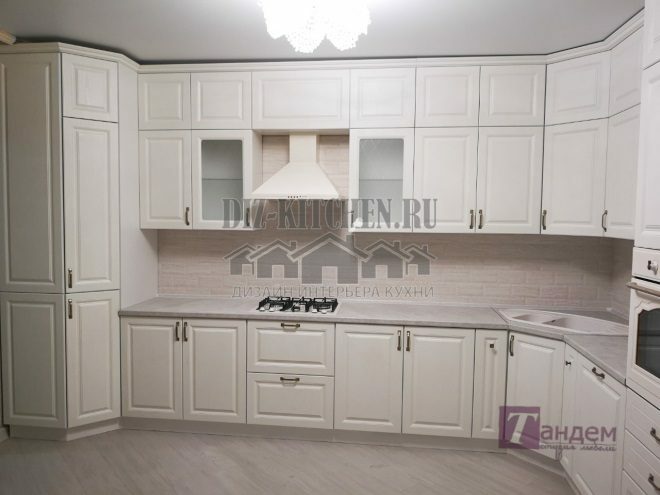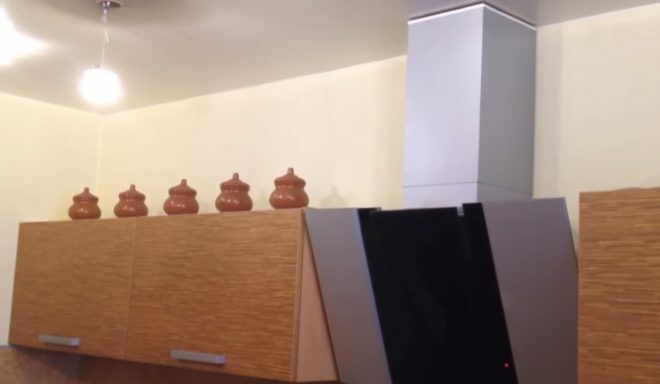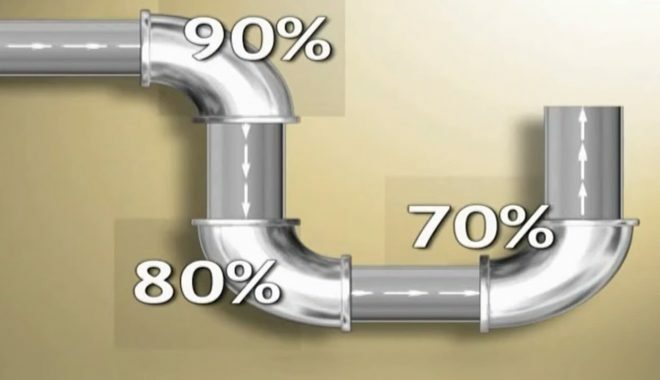The hood is an indispensable element for maintaining comfortable conditions in the kitchen. This household appliance removes all unpleasant odors and air pollution generated during the cooking process. But I want her to also look beautiful, not to spoil the interior. The air duct, especially made of aluminum corrugation, does not meet these requirements - it looks like a foreign body, rarely fitting into the existing furniture style. There are different ways to hide the corrugation from the hood in the kitchen: from cheap ones, which are easy to do with your own hands; to expensive and time-consuming, performed with the assistance of specialists.

Why are pipes hidden?
The main end result of these efforts is that the hood, together with the air duct, should harmoniously fit into the kitchen space, not “cut” the eyes. It is not always even necessary to hide the pipe from the hood. So, in a kitchen decorated in high-tech or loft style, such a metal element rather complements the overall look than spoils it. If you use a rectangular plastic pipe, it doesn't attract attention and looks good in most modern light kitchens.
Attention! Earned on our website kitchen designer. You can familiarize yourself with it and design your dream kitchen for free! May also come in handy wardrobes designer.
There is no chimney in the recirculation hoods, as they purify the air and return it back to the room through a filter system, rather than discharge it into the ventilation shaft. And the hood itself is often small, has a neat appearance and does not require masking.
And yet, most people use ducted hoods. They purify the air better, last longer, do not require complex maintenance and filter replacement. And the simplest and cheapest air duct - aluminum corrugation, unfortunately, does not at all improve the look of the kitchen.

Five options for masking the chimney
The choice of how to close the corrugation from the hood is determined by many factors. It depends on the height of the ceiling, the length and shape of the duct itself, financial capabilities, the stage of work (repairs are just being done or already completed) and, of course, the style of the kitchen.
All the numerous versions can be summarized in 5 main types.
Plastic box
A plastic box will help to hide the hood in the kitchen if the pipe is small in length and without bends. This is possible if the outlet to the ventilation shaft is located directly above the hood and stove. The stores offer plastic boxes of different colors, shapes and sizes, so choosing the right product will not be a problem.

Drywall box
A common and effective way to hide an exhaust duct is to make a drywall box. From this material, you can build a structure of any shape. Drywall is an inexpensive material, and most non-professionals can work with it.
To begin with, outline the contours of the future box on the wall and ceiling with a pencil. To keep the lines straight, use a level and a ruler. It should be borne in mind that a distance of about 3 cm on each side must remain free between the pipe and the walls of the box.
Next, metal guide profiles are attached, to which small pieces of metal structures are fixed evenly along the entire length. Plasterboard sheets of the required size are fixed to the finished frame. The result will be a protrusion from the wall or in the corner between the wall and the ceiling along the entire length of the pipe. It can be painted to match the color of the walls, pasted over with wallpaper, covered with a stretch canvas, and installed lamps.

Image taken from https://www.youtube.com/watch? v = c82HwtEHHgo
We build into a kitchen set
A simple and convenient solution to how to hide the exhaust pipe in the kitchen is to use furniture for this purpose. In the cabinets of the upper row of the kitchen set, holes are made for the duct pipe. One cabinet is placed above the hood. Sometimes the hood itself is built in, leaving only the control panel free.
If the pipe further turns to the side, a hole is made in the upper part for it in the neighboring cabinets. So, the entire course of the corrugation remains hidden from view until the very exit to the ventilation system of the building. At the top, the outlet is closed with a decorative grill, and at the bottom, it is advisable to install a special valve that prevents exhaust air from entering the room again.
The cabinet located above the stove can also be used to install a circulation type hood. It does not have a pipe, but the space above the hood is not empty, but is used to store dishes and other kitchen utensils.

Image taken from https://www.youtube.com/watch? v = 9A7p9rJxoec
Decorating
It's even easier to paint the pipe in a color that matches the design of the kitchen. True, the effect of such a disguise will not suit everyone.
In cases where the pipe runs along the wall above the cabinets, the installation of a decorative plinth or cornice along the front edge of the top of the furniture would be a good solution. The air duct in the corner between the wall and the upper cabinets is almost invisible, and with an increase in the height of the facades, it is not visible at all. A decorative molding is well suited for a classic kitchen design. You can install a panel that simulates the continuation of cabinets.

The least space above the cabinets is occupied by pipes with a rectangular cross section. It is important that the cross-sectional area of the pipe is not less than the area of the outlet of the ventilation shaft. Otherwise, there will be insufficient traction.
Stretch ceiling
If they plan to close the duct even during the kitchen renovation, you can opt for a stretch ceiling. Beautiful designs are guaranteed. The only negative is that there is a risk that in the event of a breakdown, it will be necessary to disassemble the structure, which is not very convenient and expensive. Moreover, the installation of a stretch ceiling requires special equipment and professional skills.
Easier to reach if the suspended ceiling is made of panels or tiles. In this case, you can only dismantle a part of the ceiling in the immediate vicinity of the duct, and then easily put everything in place.
Another way out is to create a two-level ceiling. Along the perimeter of the kitchen, you can construct a second level, under which the pipes will not be visible. The bottom row can be arranged in places: one above the kitchen unit and the hood, the other above the dining table or bar.
Structures that are created to mask the duct can serve other functions. Sometimes they are decorated in bright colors that contrast with the walls and the upper level of the ceiling. Then they become the main accent in the kitchen, make it unique. They can be used for additional spot lighting. This will improve the working environment in the work area and will look attractive.
It will be possible to hide engineering communications under the ceiling with a high room height. When constructing a suspended or stretch ceiling, about 15 cm of height is lost. In cases with a small kitchen, it is better to think about another option for masking the duct.

Image taken from https://www.youtube.com/watch? v = zALjda0slhQ
Requirements for materials for pipe termination
The materials that cover the pipes must meet certain criteria:
- Be resistant to temperature, steam.
- Have good sound insulation properties.
- Do not lose color over time from exposure to sunlight.
- Easy to clean, withstand chemical wash.
- Fire safety.
Plasterboard, metal, plastic or wood are commonly used. The features of the materials should be taken into account.
Plastic pipes can fade when exposed to direct sunlight, are easily damaged by impact, and are scratched. Round pipes create less resistance to air movement, therefore, the efficiency of the hood will be higher. Rectangular pipes are less noticeable in the interior, but they should not be more than 3 meters in length to create good traction, and the turns should not be at an acute angle. In addition, before purchasing, you should make accurate measurements, select all the details (straight sections, sleeves for bends, fastenings) so that the assembled structure corresponds to the distance from the hood to the ventilation mines.

Image taken from https://www.youtube.com/watch? v = Nb0o7q_P4IM
Before installation, the corrugation must be well stretched, then there will be less noise during the operation of the device, better conditions for air movement. In contrast to plastic and steel products with a smooth surface, aluminum corrugation becomes more dirty from the inside: particles of grease, dust, and burning settle on the folds.
Wood is used to seal pipes if there is wooden furniture in the kitchen. To increase resistance to aggressive factors, it is covered with protective materials.
Each of the proposed options has its own pros and cons. It is better to plan how the kitchen will look in advance, thinking over and taking into account all the details. Then it will be possible to realize most of the desires, to optimally combine functionality and beauty of performance.
average rating 0 / 5. Number of ratings: 0
No ratings yet. Be the first to rate.


